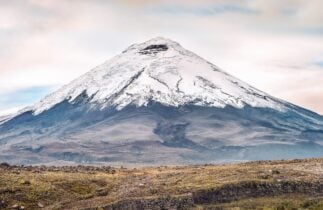Local Guide Shares the 6 Best Spots for Climbing in Oregon
Table of Contents
There’s more to rock climbing in Oregon than Smith Rock. I know, I was surprised too. While the state isn’t quite as bright and granitic as California to the south, nor as mountainous as Washington to the north, Oregon offers an amazing variety with much smaller crowds (with one major exception) and deserves recognition as one of the best states for rock climbing. Speaking of which, Smith Rock is a world-class crag where full-fledged sport climbing took hold in the U.S. If you enjoy stellar rock and history, you can climb some of the original classics in the States here.
Interestingly, most of the rock is volcanic in Oregon. Don’t let that fool you into thinking it’s all the same, though. Trout Creek offers top-notch crack climbing. Further west, the Mt. Hood forest features scattered basalt crags in a lush setting. Close to Eugene and Salem you have climbing at The Callahans and Willamette Valley. And finally, for the city-bound Portlandite, Broughton Bluff and Madrone Wall are among several crags just minutes from the city.
Read on for my six favorite climbing areas in Oregon: the ones you’ve never heard of, plus one you certainly have since it’s one of the best places for rock climbing in the world.
I Love Oregon Rock Climbing. Put That on a Sticker
Even though I grew up on the north side of Chicago, I was lucky to have a father devoted to the outdoors. I call canoeing my dad’s mid-life crisis. He would drag my brother and me up to Wisconsin, where he had bought a cabin (again, mid-life crisis), every summer, fall, winter. This really helped plant the seed for later.
As fate would have it, my brother invited me to Utah where he was living and I wound up teaching skiing for a few years. Being out there with other like-minded outdoor-oriented people got me into climbing. After several intense years of guiding in the Midwest and New Hampshire, my wife and I relocated to Portland, Oregon. I now guide across the state, seeking out and enjoying the diverse selection here. For the rock. Believe me, I’m as shocked as you are, but it’s great. Let me tell you all about it.
1. French’s Dome
French’s Dome is an andesite gem of Oregon rock climbing. The 160’ monolith rises—just slightly—out of the evergreen canopy to the west of Mt. Hood. What I love is that some of the routes are two pitches long and top out on the formation itself. Your first time up you’ll unexpectedly encounter a small forest growing there, and picturesque views of Mt. Hood, of course.
For Portland climbers, it is one of the closer crags to the city, and the formation is only a few hundred feet from the parking. Because of its higher elevation and shade, it’s a great afternoon and summer reprieve.

Admittedly, French’s Dome is a bit limited in terms of sheer quantity of routes, being a single formation, but the ambiance and spread of grades make up for all that. It has almost every level of difficulty to offer, from bolted 5.4s to a lone 5.13. My personal favorite, and one that everybody talks about, is Giant’s Staircase. Rated 5.6, it is a great two-pitch beginner route with the thrill of topping out. You can take someone who has never climbed before, or even a kid, and they can just go and have a rad day out climbing this rig. Oh, and no need to bring the rack. Almost every climb here (at least the ones worth doing!) are fully bolted.

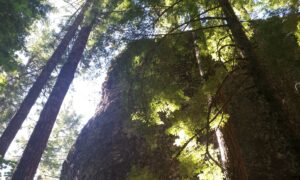
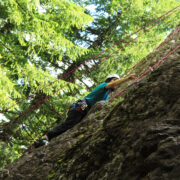
French’s Dome - Good to Know
About 30 routes, 80 to 160’ high, all but one of which are fully bolted
Best for all levels, though a majority lie in the 5.8 range and from 5.11 to 5.12
Best from late spring to early fall, and gets afternoon shade
Entry fee of $5 daily or $30 annually. Passes can be obtained from the Zig Zag ranger station
From Portland, take Highway 26 towards Mt. Hood. At the town of Zig Zag take a left onto Lolo Pass Rd., and continue for roughly 6 miles. The Dome is not clearly visible from the road, but there is an obvious dirt parking lot on the right with a sign. Take the small trail downhill from the parking area to the Dome. Most of the climbing is on the left side
Plan on hiking and taking in the scenery
This is Mt. Hood National Forest, so there is plenty of legit camping nearby. Plan ahead as it fills up on the weekends. McNeil Campground is a popular paid camping area, but for those on a more modest budget, free car camping is available on side roads like NF18. The town of Welches has the nearest gas station, grocery store and outdoor shops, plus lodging for those averse to camping
Northwest Oregon Rock by Tim Olson (2012)
2. Trillium Lake Crag aka Mosquito Butte
Most people call it Trillium Crag, but some of the old guidebooks refer to it as Mosquito Butte. Let that be a warning, bring bug spray during the warmer months!
In the summertime, this feels like one of the most popular spots in all of Oregon. You’ll be vying for spaces alongside hikers, picnickers, swimmers, kayakers, and tourists, and rest assured parking will be an issue. Still, this is a great little crag on the same type of rock as Frenchman’s Dome, and like the Dome, it is a great place for beginners.

A few years ago I spent a lot of time here, and posted it online in the hopes that it would gain more attention. This proved to be the case, and several volunteers returned to spruce it up, adding anchors and maintaining old ones. In fact, as of 2019, all the anchors have been replaced with stainless steel ½-inch bolts, hangers and rap rings, thanks to the hard work of the Portland Area Climbers Coalition and the American Safe Climbing Association.
Though the cliff isn’t particularly tall, there is a great spread of routes close together, so you can get a lot of climbing in. On the way out, be sure to jump in the lake to cool off—this might be the best feature of the crag!



Trillium Lake Crag aka Mosquito Butte - Good to Know
About 20 or so routes. Roughly 30 feet high. Opportunities for trad, sport, and TR
Best for beginner to intermediate climbers. Most routes are between 5.7 to 5.9, and maxes out at 5.11
Best from late spring to early fall, with morning shade
From Portland, take Highway 26 to the tiny hamlet of Government Camp. Once past town, turn right on forest road 2656 (If you hit the split with Hwy 35 you have gone too far). There should be signs for Trillium Lake Campground and Day Use areas. Drive to the end of the road, which is the Day Use parking area. Take the Trillium Lake North trail, around the lake. At the northeast corner of the lake, near the marsh area, is a climber’s trail on the right. Follow this for 5-10 minutes to the crag
Trillium Lake is a great attraction, and offers a wealth of opportunity for non-climbing related outdoor activities like swimming and kayaking
If you’re looking to make a trip of it, as opposed to just checking it out for the day, stay in the campground. You have to reserve well in advance, though. Camping has a few advantages: t’s gorgeous; eliminates the worry of busy summertime parking; you can simply walk to the crag from camp. McNeil campground is another option, and again, book early. The town of Welches has a gas station, grocery store and outdoor shops, plus lodging for those averse to camping. The town of Rhododendron is also nearby, and also has a grocery and some fast food
Northwest Oregon Rock by Tim Olson (2012)
3. Smith Rock State Park
It is no exaggeration to say that Smith Rock was the birthplace of modern sport climbing in America. Located about 30 minutes outside of Bend, Oregon, this former backwater has grown into one of the world’s finest with over 1,500 routes. Simply, every sport climber needs to visit Smith Rock.
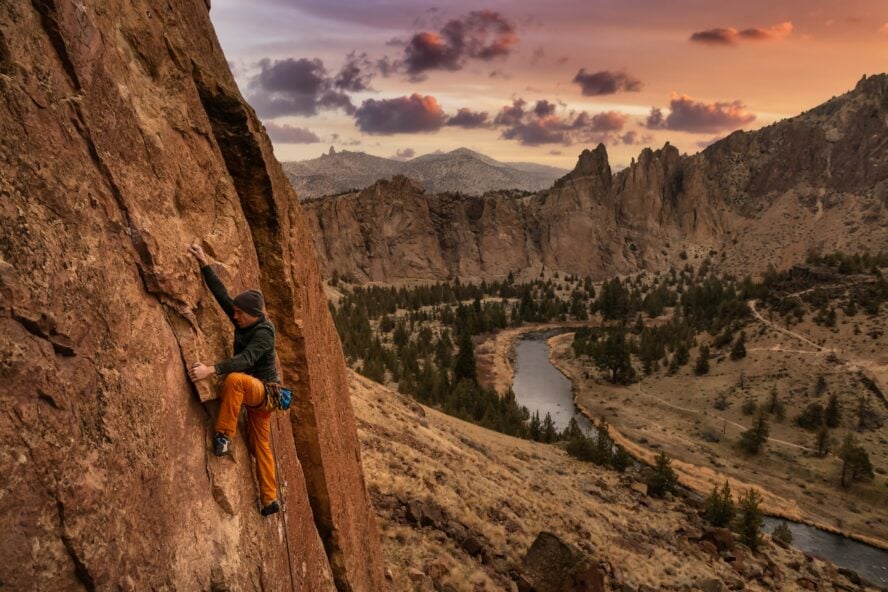
Today, any given weekend (and many weekdays) the place is swarming. But get this, back in the early 80s sport climbing simply did not exist and Smith Rock was a non-factor. Before draws and bolts, climbers had to place their own gear to get up routes. But the volcanic tuff isn’t as reliable as, say, the solid granite in Yosemite, so Smith was only visited by the hardiest of locals. (Can you imagine having this desert oasis all to yourself?) I know, that may seem crazy given the proliferation of sport crags and gyms all over the country, and hey, being in the Olympics.
Enter Alan Watts, a young, hungry and motivated climber. Watts began climbing here in 1975 and it didn’t take him long to work through the established routes, which topped out at 5.11d. He began exploring the “blank” (read: unprotectable) faces in between the cracks and eventually, this approach would lead to what many consider the first official “sport route”, Watts Tots (5.12b) in 1982. The rest is history. If you’re interested in more on the early days of sport climbing, I highly recommend picking up a copy of Hangdog Days by Jeff Smoot.
The climbing itself is mostly vertical and crimpy, but some steeper walls full of huecos and jugs do exist. Listing all the classic routes is beyond the scope of this article, but I do want to share with you my favorite moderate, 5 Gallon Buckets (5.8). It is a fully bolted jug-haul up gigantic huecos, for about 70 feet. Just so fun! For the die hard trad climber, there are a few select gear lines as good as the climbing in the Gunks, such as the four-pitch Zion (5.10a). Or trek down to the Lower Gorge, with basalt column gear climbing similar to Trout Creek.
It is no exaggeration to say that Smith Rock was the birthplace of modern sport climbing in America.

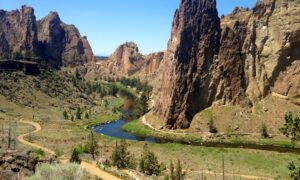
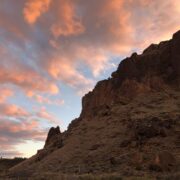
Smith Rock State Park - Good to Know
Oregon’s crown-jewel. A world-renowned historic crag with about 1,500 routes, from 5.3 to 5.14d. The site of the first sport routes in the U.S., as well as the first 5.14
Great for all abilities and all styles, but sport climbs are the majority
Shoulder season crag, best in spring and fall. Dry climate with nearly 300 days of sunshine a year
Parking is $5/day, or $30 for the season
From Terrebonne, take Hwy. 97 to Smith Rock Drive East. Take a left on 17th Street, then a right on Wilcox Ave. The last turn is a left on Crooked River Drive, which is followed to the parking area
Check out the city of Bend. Mountain biking, kayaking the Crooked River, and horseback riding are all great choices as well
You can tent camp at the Smith Bivy, located just before the parking lot. Sites are $8 per person per night. Further afield, the Skull Hollow campground is a little cheaper at $5 per car a night, but there is no water so you’ll need to stock up. It is also first-come first-serve, and gets busy on the weekends. Nearby Terrebonne has a gas station and some restaurants, and beyond that Redmond has groceries, bars, motels, etc.
Rock Climbing Smith Rock by Alan Watts
4. Trout Creek
Trout Creek is the best crack climbing in Oregon, and is essentially the Indian Creek of the northwest.
But first, let’s get the big negative out of the way: the approach is annoying, for some, as it takes over an hour. Masochists and traddies will like it, though! After a scenic stroll along the river, one of the better spots for kayaking in Oregon, the approach gains about 1,000’ through talus fields up to the base of the wall. Because of the approach, this isn’t a good place to take your kids or dogs.

Once there, however, the setting is fantastic with expansive views across the river. The cliff itself is made up of columns of basalt, and the talus and base is made up of stacks and pillars that have fallen over. This gives the whole place a medieval vibe, like being in an ancient throne room.
As far as the climbing, it effectively manages the gaps between the columns. This means a lot of vertical cracks, and stemming dihedrals when the columns are offset, which they commonly are. My favorite pitch here is definitely Gold Rush (5.10-). It takes bomber gear (mostly #2’s) and is basically a perfect 70-foot endurance hand crack. Delightful!
I’d like to stress the importance of respecting the golden eagle closure, which lasts from January 15th until August 15th (or May 15th if the nest is unsuccessful). The Bureau of Land Management requests climbers don’t hike above the river during this time. Keeping access going at Trout Creek depends on climber compliance!
Climbing Around Portland
I would be remiss not to mention Broughton Bluffs and the Madrone Wall, which are close to the capital city—and most of the climbers. Both areas are great for pre-or-post-work sessions, and because of the proximity, rest assured they will be crowded on the weekend. It is worth pointing out that these aren’t the only climbing areas close to Portland: Carver, Rocky Butte, and the Viento Wall are worth checking out too. For the PDX hardman or woman, have a look at the Rat Cave for steep tuggin’.
If you’re visiting the city, Portland offers a lot. Locals will tell you the show Portlandia is spot on, so expect quirks and characters. For example, the World Naked Bike Ride has become a yearly tradition since 2004—get ready to drop your drawers and take a ride to protest fossil fuel dependence! For something more conventional, you can take in a Trailblazers game if pro sports is your bag. One thing everyone can agree on is the great food and drink: check out a few of the over 600 licensed food trucks in the city, and then sample one of 58 breweries. But best make sure that indulgence comes after you have earned your rest day (keep reading)!



Trout Creek - Good to Know
Oregon’s premier crack-climbing destination, with over 100 routes from 5.6-5.13+ on unique basalt columns
Best for intermediate to advanced trad climbers only. There are almost no bolts (except on the well-maintained anchors), and the majority of routes start at 5.10
Mostly west-facing; year-round climbing is possible by chasing sun vs. shade
Closes every January 15th for golden eagle nesting. It reopens either May 15th or August 15th, depending on the success of the nests drive. Park all the way at the Day Use area. From here, take the river road over a cattle guard upstream for about 25 minutes. After a second cattle guard, take a left up the hillside to the obvious climbing area. Alternately, if you are looking to climb at the northern end, there is an earlier trail that leaves the river road, just past a bench on the right. Since the cliff base is tough to navigate, it’s worth planning your day ahead and selecting the appropriate approach trail
Trout Creek is pretty remote, so unless you pick a river activity you will be pretty bored
Camping at Trout Creek is pretty sweet if you can snag a site. It is right along the Deschutes River just before the main parking, so you’ll be vying for space along with fishers and boaters. For other amenities like fast food, gas and groceries, the town of Madras is about 20 miles away and has what you’ll need
Rakkup offers a digital app, otherwise Mountain Project has some info
5. Broughton Bluff
Broughton is an awesome basalt crag, made all the better by being so accessible from Portland. For me, I like the fact that it has many styles of climbing. Most routes, even if they have some bolts, require a few pieces of trad gear to be safe. This is simply how the local ethic developed here: bolts were only added in the absence of natural gear. If this sounds scary, rest assured no one is trying to sandbag you! The route descriptions on Mountain Project, for example, clearly make the distinction. And, even if the route winds up being spicy, well, at least the anchors are always bomber!

If you or your group leader is proficient with gear (there isn’t really top access except for one little spot) then this is a great beginner’s crag with some decent 5.6s and 5.7s. If you’re also looking for a little adventure, there are a few 2 and 3 pitch climbs, like the popular three-pitch, 5.9+, Gandalf’s Grip.
Gandalf’s Grip is my personal favorite. There are a few bolts, but you really need gear and a good head. It’s a relatively accessible grade and the crux doesn’t require brute strength, but is rather all about technique and getting your balance just so. If you go try it, a little bit of local beta: don’t top out the third pitch as it is super awkward. Instead, utilize the anchor and lower back to the top of the second pitch, and have your follower clean and rap off back to you.
I also have to mention two other lines: Classic Crack and Shear Stress. Classic Crack is a short but fantastic 5.9+ that really earns the “+”, as it has gotten a bit polished over the years. For such a short pitch, it has an amazing variety of crack sizes to contend with. And to top it all off, it even stays dry in the rain, protected by large overhangs above. Shear Stress, on the other hand, is a two-pitch 10a that is a bit more technical and some outstanding crack climbing. Both climbs protect well, so give them a try!



Broughton Bluff - Good to Know
Roughly 150 routes on a dozen or so basalt cliffs, up to 160’ high. A mix of trad, sport, and TR. Many of the routes feature a mix of gear and bolts
Great for all abilities: routes from 5.6 to 5.13d, with some projects thought to be even harder
Year-round climbing is possible, but late spring, summer, and fall are best
From Portland, take I-84 east to the Lewis and Clark State Park exit. At the stop sign, turn left and drive under the railroad bridge, then park at the parking lot on the left. Follow the trail that heads up the hillside for a few hundred yards to the cliff
This is a day trip from Portland so you’ll be hanging out there
Plenty of options in Portland
Portland Rock Climbs by Tim Olson (2011)
6. Madrone Wall
Madrone Wall is an amazing access story, and shows the potential for what can happen when land managers and user groups work together. The jist is this: the area was turned into a park instead of a quarry.
Less short, but still abbreviated version: several hard-working folks labored for 20 years, formed the Madrone Wall Preservation Committee, sought assistance from the Access Fund, and worked with Clackamas County (who owns the property) to turn this wonderful area into a county park. Thanks to the tireless efforts of all involved, on October 21st, 2017 Madrone Wall was officially opened to rock climbing. Enjoy this wonderful place and be respectful of the hard work that went into it!

Madrone is a rad place to plug gear. Most of the time, if there is no gear to be had, lead bolts have been installed. Additionally, bolted anchors have been placed on all routes, which in addition to being convenient and more efficient than tree anchors, protects the trees and vegetation and cuts down on clifftop erosion.
Classics at Madrone come in all shapes and sizes. Beginners will love Double Clutch Right (5.6), a popular first trad lead. Electric Everything (5.8) will appeal to those with a few more leads under their belt, and the climbing is even better. For those looking to spice it up, some of the 5.10s at Madrone are awesome: Red Sun Rising (5.10b), Rising Desperation (5.10a), and Nouveau Riche (5.10c) all offer great protection for challenging, tricky moves with a little bit of everything thrown at you.
If trad isn’t your thing, or you’re opting to just get mileage in and get a quick workout, the best sport routes at Madrone include: Extinction (5.10d), Comfortizer (5.11b), Wild Things (5.11d) and Scott Free (5.12a). These are just the tip of the bolted iceberg, so don’t feel bad leaving your rack at home, or not even having one in the first place!


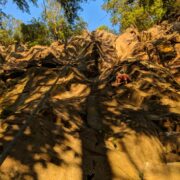
Madrone Wall - Good to Know
About 100 routes from 5.4 to 5.12; good for all abilities. Mostly trad and mixed, with some sport; bring a rack
beginner to advanced trad, some intermediate sport
Open from July to January; closed for peregrine falcon nesting February to June
Make sure to pay the $6 daily parking fee, or purchase an annual pass from the park office. Also check the hours of operation, as they change month-to-month, to ensure you are out before the park closes
From Portland, head southeast on Hwy. 224 toward Carver. Madrone Wall is on the left, just over two miles past Carver. The road to the cliff has a yellow gate. If this gate is closed, the park is closed! Do not walk around the gate! Continued access depends on your cooperation. Parking is at the top of this road, and there is space for just 20 cars, so carpool if possible. Trails lead from either end of the parking lot to the crag
see Portland section
see Portland section
Portland Rock Climbs by Tim Olson (2011). it’s a bit outdated and there are lots of new trails and anchors since. Rakkup offers a mobile app called Madrone and Carver Cliffs that is more current




